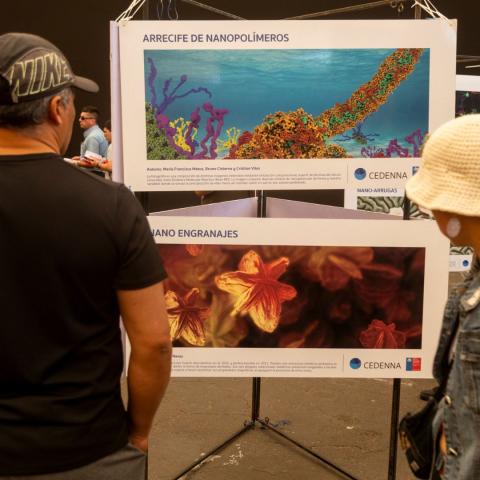
Within the framework of the Heritage Day for Girls, Boys and Adolescents, organized by the Municipality of Santiago, the Center for Nanoscience and Nanotechnology (CEDENNA) will present its traveling exhibition “Images of the Nanoworld”, a unique display that reveals the invisible wonders of matter at the nanometric scale. The National Prize for Exact Sciences, Dora Altbir, and the Director of the CEDENNA Program Center, Juliano Casagrande, will participate and engage in conversation with the public.
This Saturday, August 23, the Municipality of Santiago will celebrate the Heritage Day for Girls, Boys and Adolescents with a cultural and educational event in the Plaza de Armas, featuring a variety of activities open to the community.
As part of this program, the municipality invited CEDENNA to showcase its exhibition in front of the city hall building, where it will remain throughout the day and later be displayed inside.
The exhibition belongs to Fundación CEDENNA and will feature the participation of its director, Dr. Dora Altbir, National Prize for Exact Sciences 2019, and Dr. Juliano Casagrande, Director of the CEDENNA Program Center, who will be available to speak with the public, answer questions, and share the contributions of nanotechnology.
A window into the invisible world
For more than a decade, CEDENNA has organized an internal competition in which its researchers capture striking images of the nanoworld using high-end electron microscopy. These photographs reveal structures invisible to the human eye, many of which resemble fantastic landscapes, marine forms, or abstract figures.
The exhibition, composed of 12 selected images, offers scientific descriptions written in accessible language for a general audience. Among them, for example:
-
Butterfly: a porous hydrogel that, under the microscope, reveals shapes resembling the wings of a butterfly in mid-flight.
-
Crosses of microcrystals: tiny vanadium oxide crystals that, as they grew, formed a perfect cross, as if nature itself had played with invisible geometric shapes.
-
Nanocoral: microscopic tubes that naturally arrange themselves in structures strikingly similar to marine coral.
-
Pink jellyfish: titanium dioxide crystals that evoke the silhouette of jellyfish floating in an imaginary ocean.
-
Nanobridges: nanometric filaments connecting separate areas, reminiscent of suspension bridges in midair.
-
Magnetic nanosphere: a minute sphere made of cobalt atoms that shines like a microscopic jewel.
Science traveling across Chile
Images of the Nanoworld has toured different cities in Chile, including Antofagasta, Arica, Iquique, Valparaíso, and Santiago, as well as universities and cultural centers such as the USACH Planetarium, the Bellas Artes Metro Station, the University of Tarapacá, the Diego Portales University, and the Puerto Ideas 2025 Science Walk.
Its itinerancy has brought science closer to thousands of people of all ages, demonstrating that nanotechnology not only drives innovation in health, energy, and the environment, but can also be an aesthetic and cultural experience.
“Behind the beauty found in the nanoworld, there are many practical applications. Each of these particles can have a specific use, for example, to remove arsenic from water, improve the quality of food packaging, absorb oxygen to prevent food from oxidizing and last longer, in mining sensors, or to detect pathogens in food,” emphasizes Dr. Altbir.
This exhibition seeks to spark curiosity and interest in nanotechnology among audiences of all ages, highlighting its applications that arise from the unique properties of materials at the nanoscale. Some applications have existed for a long time, ranging from sunscreens to specialty paints, including components in our computers and cell phones, as well as revolutionary cancer treatments.
A nanometer equals one millionth of a millimeter, which is why systems at this scale can only be observed with specialized microscopy.
- Log in to post comments







